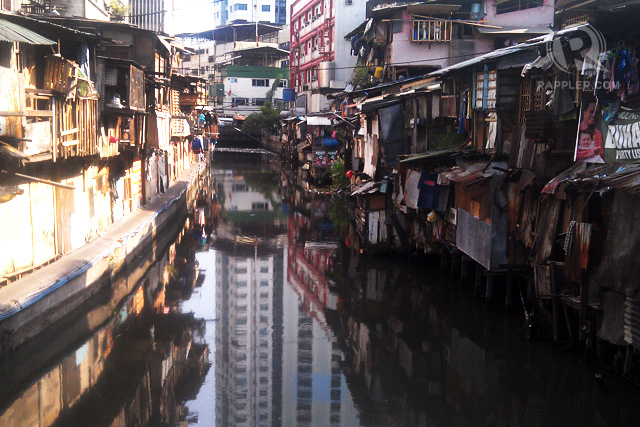SUMMARY
This is AI generated summarization, which may have errors. For context, always refer to the full article.

MANILA, Philippines – Elections or not, the national government is bent on moving 20,000 families living near waterways in Metro Manila as part of its flood control master plan.
Public Works and Highways Secretary Rogelio Singson said the Cabinet committed to President Benigno Aquino III to relocate this year the informal settlers living near what he called 8 priority waterways.
“We will work on the first 20,000 [families]. We have started. However, it is not easy to move them to resettlement sites. Some want in city, off city, out of city, many options that they want. It’s not homogenous. There are ongoing programs and a process we have to follow,” Singson said in a Palace press briefing on Wednesday, June 19.
Aquino called an emergency meeting Tuesday, June 18, to discuss the flood plan after heavy rain from tropical storm Emong and the Southwest Monsoon brought traffic in the capital to a standstill.
Singson identified the following as the 8 major waterways that need to be cleared:
- San Juan River (with 4,217 families living near it)
- Tullahan River (3,683 families)
- Manggahan Floodway (2,997 families)
- Maricaban Creek (1,687 families)
- Estero Tripa de Gallina (3,887 families)
- Pasig River (1,484 families)
- Estero de Sunog Apog (1,117 families)
- Estero de Maypajo (1,415 families)
The 20,000 families are just part of the about 100,000 families living near waterways that government intends to relocate in the long-term.
The Interior Department and the National Housing Authority (NHA) are heading the effort.
“The NHA said that in 2012, they built 18,000 housing units for informal settlers in Metro Manila. We’re trying to double that this year but the social preparation takes time. But once we get that and because there is no problem with funds, the process will speed up,” said Palace Communications Secretary Ricky Carandang.
Carandang added, “Sometimes, if you tell them there’s housing and livelihood, they won’t immediately believe that.”
Singson revealed that the process was delayed because of a request of some local officials.
“We have wanted to do this but there were many who requested not to do it before the elections and now they want to delay it again because of the barangay elections but we will no longer allow that. We will have to do something immediately,” Singson said.
The public works chief though could not identify which local officials made the request, saying it was just based on “anecdotes.”
Carandang and Singson stressed that local government officials will be held liable if the relocated families return to the disaster-prone areas.
“The national government will take the lead and clear them out but they cannot return. There will be sanctions if they do that. Under the Local Government Code, living near waterways is really prohibited but now these areas are very populated. It is the responsibility of the barangay captain,” Singson said.
Singson added, “The President already gave instructions to sanction these officials.”
Improving drainage, pumping stations
In the briefing, Carandang, Singson, and Metro Manila Development Authority Chairman Francis Tolentino identified the following as the main causes of flooding in the National Capital Region:
- High volume of water
- Drainage capacity constraints
- Low lying communities like those in the CAMANAVA area (Caloocan, Malabon, Navotas, Valenzuela City)
Singson said the government’s “high-impact, high priority projects” to address the problem include the following:
- Cleaning of waterways – to ensure that floodwaters quickly flow out to the Manila Bay and Pasig River
- Drainage improvement – Government is conducting 90 drainage improvement projects in Metro Manila. The Public Works Department is improving the drainage system from the 10-year capacity to 25-year capacity.
- Upgrading of the 12 major pumping stations in Metro Manila
- Dike construction for low-lying communities
Singson added that his department is constructing a water tunnel in Blumentritt that will be a receptacle of floodwater coming from Quezon City and headed to España, Manila. He said the project will be completed in one year.
Besides the engineering interventions, Singson said the Project NOAH, which aims to warn communities 6 hours before floods hit, and flood drills and information system are part of the master plan.
The Cabinet officials reiterated that the master plan will not provide an overnight solution to floods in the capital.
“Funding is already there. It is not an issue. We just need time to implement all these major projects we are undertaking,” Singson said.
Local officials’ political will
Tolentino said the implementation of the Solid Waste Management Act will be high on the agenda of the first Metro Manila Council meeting after newly elected officials assume their posts on July 1.
He said the MMDA is conducting an “estero blitz” to clean waterways, and deploying personnel to help in traffic and flood control until the end of the monsoon season.
“I assure you we will be present. We will seek the help of barangay officials,” Tolentino said.
The MMDA chief said local governments have a crucial role to play.
“When we look at flood control, we should also look at how zoning ordinances are implemented, why open spaces are gone, the implementation of easements in waterways, how structures like supermarkets, groceries should be properly built near waterways. So it’s a long process,” Tolentino added. – Ayee Macaraig / Rappler.com
Add a comment
How does this make you feel?
There are no comments yet. Add your comment to start the conversation.